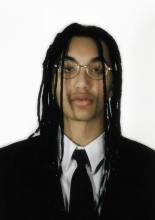During Pride Month, artist Noah Janosch Brown writes about finding a safe place in a United Church to create art and nurture self-discovery.

In the summer of 2017, I had begun my ambitious goal to produce a large body of work, deconstructing my experiences as a queer Black person in my adolescence. My realized queerness was new, and the burdensome nature of intergenerational trauma constantly presented itself in my day-to-day life.
Earlier that year, I was on the bus when two Black boys screamed homophobic remarks at me and laughed as they picked apart my every feature. The most troublesome aspect of the experience was the fact that they looked just like me. I couldn’t fathom the idea that we share the same historical background. Yet they were projecting these hurtful slurs in hopes of publicly humiliating a human they have never met before. At the time, I hadn’t even come to terms with my sexuality yet, and in retrospect, I now realize they saw something in me that even I didn’t know about myself.
I bottled-up much anger from this experience, so I chose to concentrate these thoughts on my art. This collection consisted of a series of tapestries, porcelain sculptures, industrially designed products, and photography. My 4’ x 16’ tapestry recreation of the Brookes Slave Ship model posed as my biggest obstacle in completing my imagined collection. I planned to dry-felt the entire tapestry at my high school but was later informed that the building was closed until the fall semester due to asbestos-removal.
I desperately sought a large creative space until my mom came across the Roncesvalles United Church in Toronto. Rev. Hines listened to my proposition and immediately welcomed me into her community with open arms. She brought me down to the church's basement. The room had high ceilings with a miniature child theatre and ball game markings on the ground which appeared to be remnants of a vintage gymnasium. It was the perfect studio space.
Over the course of my stay, I shared eye-opening conversations and lovely awkward stares with churchgoers. Through exploration, I began to notice the church housed several programs such as healing centres, a globalized medicine charity, and a soup kitchen. All of which directly impacted my surrounding neighborhood and beyond. The space felt safe and I began to develop a special relationship with the community of the church. One day Rev. Hines came down to pay me a visit in the church basement and asked if I would be interested in holding a speech at the next church service. I was immediately exhilarated at the thought of sharing my process and speaking to members about my creative journey.
When the day came, the service began with members of the community carrying my tapestry down the aisle to be presented before the seated churchgoers. Rev. Hines provided a compassionate introduction to my work and why the art I produced was important to the church. I then took to the stand and spoke to an attentive, predominantly White audience. They showed genuine curiosity and asked questions about my experiences as a queer Black person. The people brought understanding, humility, and the willingness to question their own past actions. After the Q&A, I was joined by the special guest soul singer, Carolyn T.
The most memorable moment of this experience were my discussions after the service with older queer members of the audience. We spoke of their experiences coming to terms with their true identity and their tribulations maturing within homophobic environments. These discussions have helped me understand my own traumatic experiences, and how experiences constantly repeat themselves.
Rev. Hines’s welcoming nature opened so many possibilities within my own life. Through this offering, I was given the opportunity to speak about my Slave Boat tapestry at the United Nations along with excellent Black figures such as Rodney Leon (architect of the Ark of Return memorial), publicly speak at the University of Toronto’s Caribbean studies program, exhibit my tapestry in the Art Gallery of Guelph, and was later signed as the youngest artist under the Patel Brown Gallery.
— My name is Noah Janosch Brown. I am a 20-year-old Toronto-based artist. I produce music under the stage name Telly in my music group TWOSIXTELLY. I am one of the participants in the Young Black Scholars Program as part of the United Church's commitment to the International Decade for People of African Descent.

The views contained within these blogs are personal and do not necessarily reflect those of The United Church of Canada.